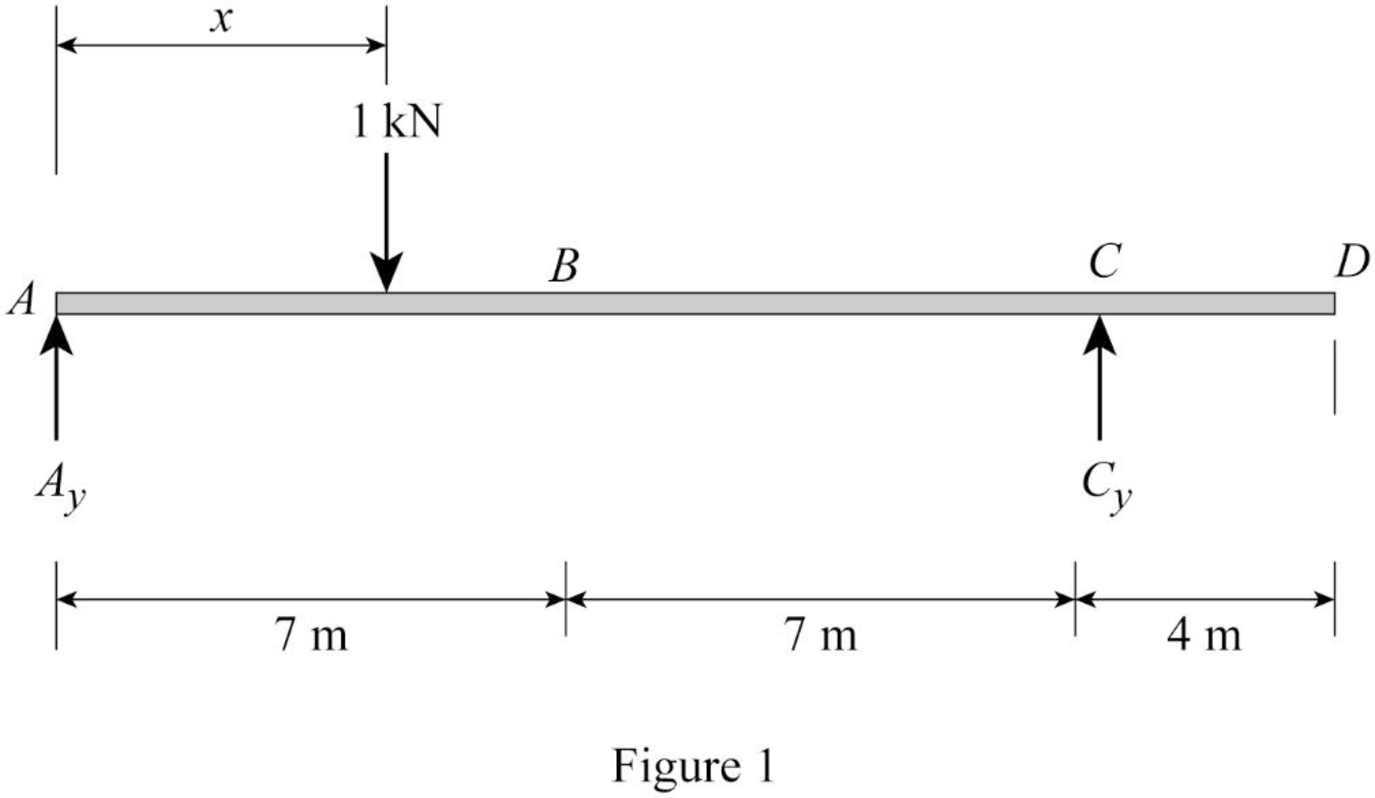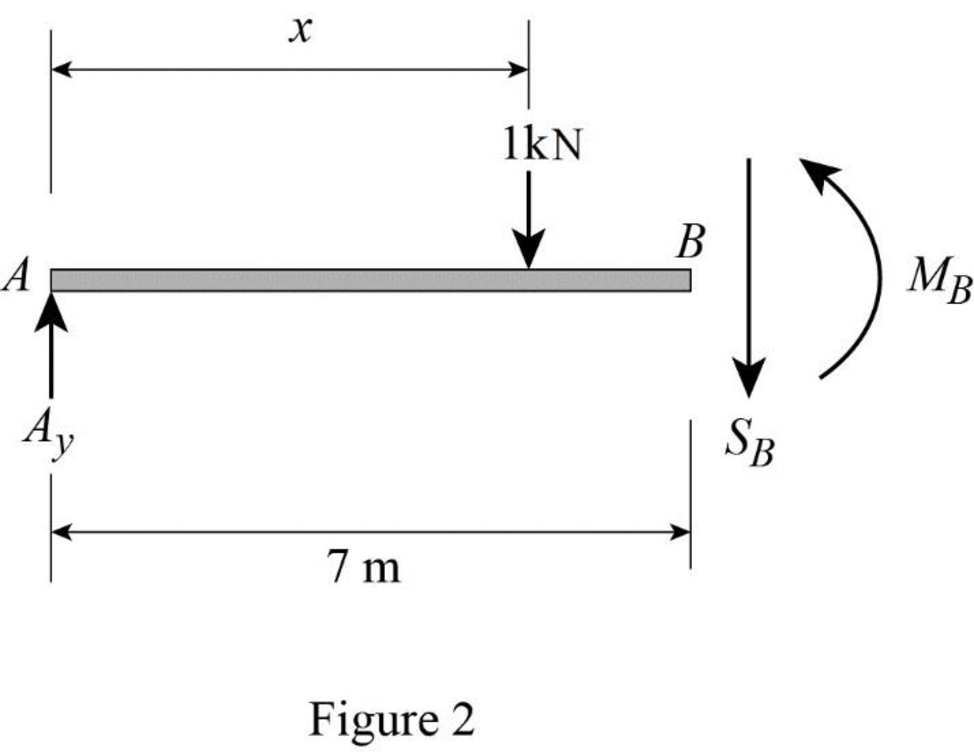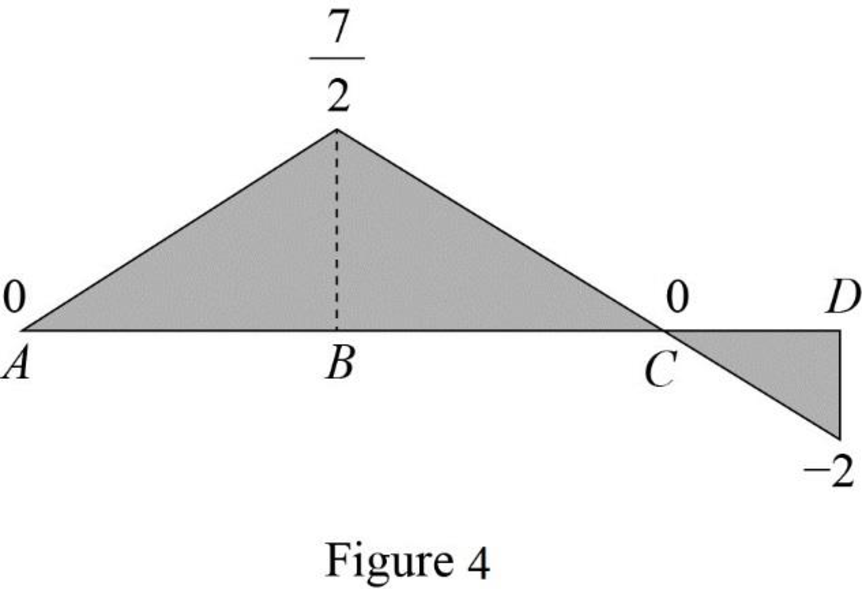
Find the maximum negative bending moment at point B.
Answer to Problem 1P
The maximum negative bending moment at point B is
Explanation of Solution
Given Information:
The concentrated live load (P) is 75 kN.
Calculation:
Apply a 1 kN unit moving load at a distance of x from left end A.
Sketch the free body diagram of beam as shown in Figure 1.

Refer Figure 1.
Find the equation of support reaction
Take moment about point A.
Consider moment equilibrium at point A.
Consider clockwise moment as positive and anticlockwise moment as negative.
Sum of moment at point A is zero.
Find the equation of support reaction
Apply vertical equilibrium equation of forces.
Consider upward force as positive
Substitute
Find the equation of moment at B.
Apply 1 kN at just left of B
Sketch the free body diagram of the section AB as shown in Figure 2.

Refer Figure 2.
Consider moment at B.
Consider clockwise moment as positive and anticlockwise moment as negative.
Substitute
Apply 1 kN at just right of B
Sketch the free body diagram of the section BD as shown in Figure 3.

Refer Figure 3.
Consider moment at B.
Consider clockwise moment as positive and anticlockwise moment as negative.
Find the equation of moment at B of portion BC
Substitute
Thus, the equations of the influence line for
Find the value of influence line ordinate of moment at various points of x using the Equations (3) and (4) and summarize the value as in Table 1.
| x | |
| 0 | 0 |
| 7 | |
| 14 | 0 |
| 28 | –2 |
Draw the influence lines for the moment at point B using Table 4 as shown in Figure 4.

Refer Figure 4,
The maximum negative influence line ordinate of bending moment at B is
Find the maximum negative bending moment at point B using the equation.
Substitute 75 kN for P and
Therefore, the maximum negative bending moment at point B is
Want to see more full solutions like this?
- I need detailed help solving this exercise from homework of Applied Mechanics.I do not really understand how to do, please do it step by step, not that long but clear. Thank you!arrow_forwardDirection: Write the answer in a bond paper with complete solutions drawings. Strictly write in bond paper and picture it. Topic: Sheer & Moment diagrams, Reaction at Supports, Load Tracing, Method of Joint, and Method of Section Course: Theory Of Structurearrow_forwardDirection: Write the answer in a bond paper with complete solutions drawings. Strictly write in bond paper and picture it. Topic: Sheer & Moment diagrams, Reaction at Supports, Load Tracing, Method of Joint, and Method of Section Course: Theory Of Structurearrow_forward
- Direction: Write the answer in a bond paper with complete solutions drawings. Strictly write in bond paper and picture it. Topic: Sheer & Moment diagrams, Reaction at Supports, Load Tracing, Method of Joint, and Method of Section Course: Theory Of Structurearrow_forwardDirection: Write the answer in a bond paper with complete solutions drawings. Strictly write in bond paper and picture it. Topic: Sheer & Moment diagrams, Reaction at Supports, Load Tracing, Method of Joint, and Method of Section Course: Theory Of Structurearrow_forwardDirection: Write the answer in a bond paper with complete solutions drawings. Strictly write in bond paper and picture it. Topic: Sheer & Moment diagrams, Reaction at Supports, Load Tracing, Method of Joint, and Method of Section Course: Theory Of Structurearrow_forward
- 1. Create Diagrams: Draw the shear and moment diagrams for the given beam. 8k 15k-ft B 12 k -6 ft- -8 ft--8 ft- -8 ft- 4k 4 ft 2 ftarrow_forward10:46 Mechanics of Deform... ← CE104.2T.24.25. FA 1 5 of 6 2.5/10 Rigid bar ABCD is loaded and supported as shown. Steel [E=27800 ksi] bars (1) and (2) are unstressed before the load P is applied. Bar (1) has a cross- sectional area of 0.83 in.² and bar (2) has a cross- sectional area of 0.45 in.2. After load P is applied, the strain in bar (1) is found to be 670 με. Assume L₁=58 in., L2-94 in., a=26 in., b=22 in., and c=36 in. Determine: (a) the stresses in bars (1) and (2). (b) the vertical deflection VD of point D on the rigid bar. (c) the load P. A L₁ B L2 a b 223 D Stream Courses Calendar Morearrow_forwardanswer thisarrow_forward
- exact answerarrow_forwardQ2: For the overhanging beam BD shown, draw the "Influence Lines" for RB, RD S.F. at C (VC) and B.M. at C (Mc) using the static equilibrium method. A B 4 m 5 m 7 marrow_forwardQ1: Draw N.F.D, S.F.D and B.M.D for the frame shown below. Knowing that t support at A is hinge, and at D is roller. B 2 m 5 kN/m C 30 kN 2 D 5 marrow_forward
